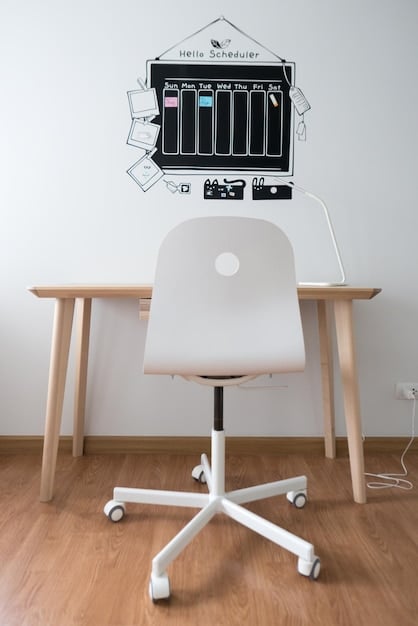Boost Your Income: Gig Worker Productivity Hacks for a 15% Raise

Gig worker productivity hacks are essential for streamlining your workflow, improving efficiency, and ultimately earning more. By implementing smart time management, organization, and tech optimization strategies, you can significantly increase your income in the gig economy.
Are you a gig worker looking to boost your income? Discover proven gig worker productivity hacks that can streamline your workflow and help you earn up to 15% more. Let’s dive in!
Understanding the Gig Economy and Productivity
The gig economy is booming, offering flexibility and autonomy. However, it also demands high productivity to succeed. Understanding how to maximize your output is crucial.
The Rise of the Gig Economy
More and more people are turning to freelance work, creating a dynamic and competitive environment.
Why Productivity Matters
In the gig economy, your income is directly tied to your productivity. Working smarter, not just harder, is the key.
- Efficient Time Management: Allocating time effectively to high-value tasks.
- Avoiding Burnout: Maintaining a sustainable work pace.
- Client Satisfaction: Delivering quality work on time.
Being productive as a gig worker means optimizing every aspect of your work, from scheduling tasks to using the right tools. By focusing on efficiency and effectiveness, you can increase your income and overall satisfaction. Ignoring productivity can lead to missed deadlines, unhappy clients, and reduced earnings. Prioritizing gig worker productivity hacks is a game-changer for those looking to thrive in the gig economy.
Time Management Techniques for Gig Workers
Effective time management is the cornerstone of gig worker success. Mastering techniques like the Pomodoro Technique and time blocking can transform your productivity.
The Pomodoro Technique
This method involves working in focused 25-minute intervals, followed by a short break.
Time Blocking
Schedule specific blocks of time for different tasks to stay organized and on track.

- Prioritize Tasks: Identify and focus on the most important tasks first.
- Set Realistic Deadlines: Avoid overcommitting and missing deadlines.
- Minimize Distractions: Create a dedicated workspace to stay focused.
Time management is not just about doing more; it’s about doing the right things at the right time. By employing strategies such as prioritizing tasks, setting realistic deadlines, and minimizing distractions, gig workers can optimize their workflow and enhance their productivity. Embracing these time management techniques is an investment in long-term success in the gig economy.
Leveraging Technology to Boost Productivity
Technology offers numerous tools to enhance gig worker productivity. From project management software to communication platforms, the right tech can make a significant difference.
Project Management Tools
Apps like Trello, Asana, and Monday.com help organize tasks, track progress, and collaborate with clients.
Communication Platforms
Use tools like Slack, Microsoft Teams, or Zoom for efficient communication and collaboration.
Technology plays a crucial role in streamlining workflows and enhancing communication for gig workers. Leveraging project management tools can help organize tasks, track progress, and collaborate with clients effectively. By investing in the right technology, gig workers can optimize their operations and improve overall productivity. Ultimately, the strategic use of technology is a key differentiator for success in the gig economy.
Creating an Optimized Workspace
The environment in which you work significantly impacts your productivity. Setting up an optimized workspace can help you stay focused and motivated.
Ergonomic Setup
Invest in a comfortable chair, monitor, and keyboard to prevent physical strain.
Minimize Clutter
A clean and organized workspace reduces distractions and promotes a clear mind.

- Natural Light: Position your workspace near a window for natural light.
- Personalize Your Space: Add plants, photos, or other items that inspire you.
- Dedicated Workspace: Have a designated area solely for work.
Optimizing your workspace is about creating an environment that promotes focus, comfort, and motivation. By investing in ergonomic equipment, minimizing clutter, and personalizing your space, you can significantly enhance your work experience. A thoughtfully designed workspace not only boosts productivity but also contributes to your overall well-being, making it an essential element for success in the gig economy.
Strategies for Client Communication and Collaboration
Effective communication is key to building strong client relationships and ensuring project success. Implementing clear and consistent communication strategies can enhance productivity and client satisfaction.
Set Clear Expectations
Clearly define project scope, timelines, and deliverables from the outset.
Regular Updates
Provide clients with regular progress updates to keep them informed and engaged.
Clear and consistent communication with clients is essential for managing expectations, preventing misunderstandings, and fostering trust. By setting clear expectations, providing regular updates, and actively seeking feedback, gig workers can cultivate strong professional relationships with their clients. Ultimately, effective communication fosters both productivity and client satisfaction, leading to long-term success in the gig economy.
Maintaining Work-Life Balance as a Gig Worker
The flexibility of the gig economy can blur the lines between work and personal life. Establishing healthy boundaries is essential for avoiding burnout and maintaining well-being.
Set Boundaries
Establish specific work hours and stick to them. Communicate these hours to clients.
Schedule Breaks
Incorporate regular breaks throughout the day to recharge and prevent burnout.
- Prioritize Self-Care: Make time for activities that promote your physical and mental health.
- Disconnect Regularly: Set aside time each day to completely disconnect from work.
- Learn to Say No: Avoid overcommitting yourself by declining additional work when necessary.
Work-life balance is essential for maintaining your well-being and productivity in the long run. Over time, not having balance can lead to increased stress levels, decreased job satisfaction, and burnout, which can negatively impact both your health and your income. By prioritizing self-care, setting clear boundaries, and building support networks, you can manage the demands of the gig economy while also thriving personally. Creating a healthy work-life balance helps ensure your sustainability and success as a gig worker.
Financial Management Tips for Gig Workers
Managing finances effectively is crucial for gig workers, given the variable nature of income. Implementing smart financial strategies can provide stability and peace of mind.
Track Your Income and Expenses
Use accounting software or spreadsheets to monitor your cash flow and expenses.
Set Aside Taxes
Estimate your tax liability and set aside funds regularly to avoid surprises.
- Create a Budget: Develop a comprehensive budget to manage your finances effectively.
- Save for Retirement: Contribute to retirement accounts to secure your financial future.
- Emergency Fund: Build an emergency fund to cover unexpected expenses.
Financial management is crucial for weathering the income fluctuations inherent in gig work. Proactive budgeting, saving for emergencies, and planning for retirement are essential components of financial security. These strategies not only provide a safety net but also empower you to achieve your financial goals, making you self-sufficient. Effective financial management is a key factor in achieving long-term stability and success in the gig economy.
| Key Point | Brief Description |
|---|---|
| ⏱️ Time Management | Utilize techniques like Pomodoro and time blocking. |
| 💻 Tech Leverage | Use project management and communication tools. |
| 🏢 Optimized Workspace | Create an ergonomic, distraction-free workspace. |
| 💬 Communication | Maintain clear and regular client communication. |
Frequently Asked Questions
▼
The Pomodoro Technique enhances focus by structuring work into 25-minute intervals followed by short breaks. This method prevents mental fatigue, keeps your mind fresh, and promotes consistent output.
▼
Popular project management tools include Trello, Asana, and Monday.com. These platforms allow you to organize tasks, track progress, and collaborate with clients efficiently, ensuring projects stay on schedule.
▼
An ergonomic workspace includes a comfortable chair, an adjustable monitor at eye level, and a keyboard that allows your wrists to remain straight. Good posture and proper equipment reduce physical strain and boost focus.
▼
Clear and consistent communication ensures that clients are always informed and expectations are met. It minimizes misunderstandings, builds trust, and fosters stronger professional relationships for ongoing collaborations.
▼
Preventing burnout involves setting boundaries, scheduling breaks, and prioritizing self-care. Disconnecting from work regularly and learning to say no to additional projects when needed helps maintain a healthy work-life balance.
Conclusion
Adopting these gig worker productivity hacks can significantly streamline your workflow and boost your earning potential. By implementing effective time management, leveraging technology, and prioritizing self-care, you can thrive in the gig economy.





